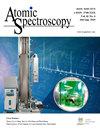地质材料无损微x射线荧光定量分析
IF 2.3
2区 化学
Q1 SPECTROSCOPY
引用次数: 2
摘要
微x射线荧光(µXRF)是一种原子光谱学,用于使用x射线光束分析样品的微区域,并通过在单个像素位置的光谱采集来绘制样品上的元素分布。我们已经研究了快速和非破坏性的微XRF分析的潜力,通过校正无标准基本参数(SFP)定量数据来定量确定地质样品的化学成分。在对一套国际认证标准硅酸盐玻璃进行分析比较的基础上,建立了μXRF SFP定量数据与na2o、MgO、al2o3、sio2、k2o、CaO、tio2、MnO和FeO认证值之间的线性关系,并计算了相应的校准方程。对平面或不均匀玻璃的进一步测试表明,所有主要元素的校准结果与认证值相似,精度提高了~10%。对典型地质材料(包括纯矿物、非均质玄武岩和微区)的分析表明,校准结果更接近大多数元素的认证/参考值。这项研究表明,微XRF是一种很有前途的技术,可以在微尺度上快速、无损、定量地研究样品的化学成分。本研究开发的µXRF测量和校准方程可用于快速表征地质材料和无损分析珍贵的地外物质。本文章由计算机程序翻译,如有差异,请以英文原文为准。
Non-Destructive Micro X-Ray Fluorescence Quantitative Analysis Of Geological Materials
: Micro X-ray fluorescence (µXRF) is an atomic spectroscopy for analyzing micro areas of a sample using Xray beams and mapping elemental distribution on the sample by spectrum acquisition at individual pixel positions. We have examined the potential of rapid and non-destructive µXRF analysis to quantitatively determine the chemical composition of geological samples by correcting standardless fundamental parameters (SFP) quantification data. Based on analysis and comparison of a set of certified international standard silicate glass, linear relationships between μXRF SFP quantification data and certified values of Na 2 O, MgO, Al 2 O 3 , SiO 2 , K 2 O, CaO, TiO 2 , MnO, and FeO were developed, and the corresponding calibration equations were calculated. Further tests on flat or uneven homogeneous glass demonstrated that calibrated results of all major elements were similar with certified values, with improved accuracy of ~10%. Analysis of typical geological materials, including pure minerals, heterogeneous basaltic rock, and micro areas, indicated calibrated results were closer to certified/reference values for most elements. This study reveals that µXRF is a promising technique for rapid, non-destructive, and quantitative investigation of chemical composition of specimens at the microscale level. µXRF measurements and calibration equations developed in this study could be used to rapidly characterize geological materials and non-destructively analyze precious extraterrestrial materials.
求助全文
通过发布文献求助,成功后即可免费获取论文全文。
去求助
来源期刊

Atomic Spectroscopy
物理-光谱学
CiteScore
5.30
自引率
14.70%
发文量
42
审稿时长
4.5 months
期刊介绍:
The ATOMIC SPECTROSCOPY is a peer-reviewed international journal started in 1962 by Dr. Walter Slavin and now is published by Atomic Spectroscopy Press Limited (ASPL). It is intended for the rapid publication of both original articles and review articles in the fields of AAS, AFS, ICP-OES, ICP-MS, GD-MS, TIMS, SIMS, AMS, LIBS, XRF and related techniques. Manuscripts dealing with (i) instrumentation & fundamentals, (ii) methodology development & applications, and (iii) standard reference materials (SRMs) development can be submitted for publication.
 求助内容:
求助内容: 应助结果提醒方式:
应助结果提醒方式:


